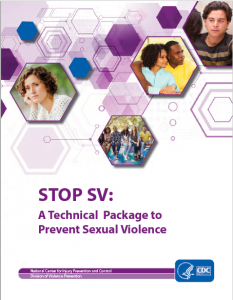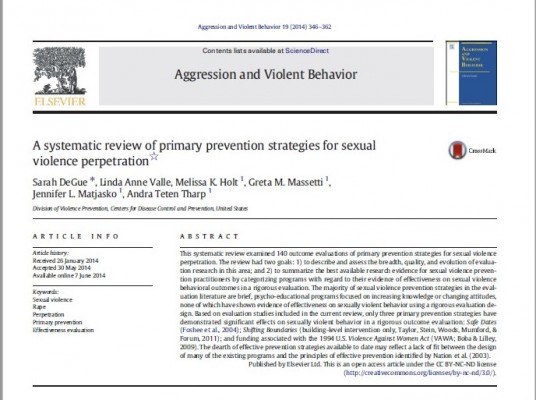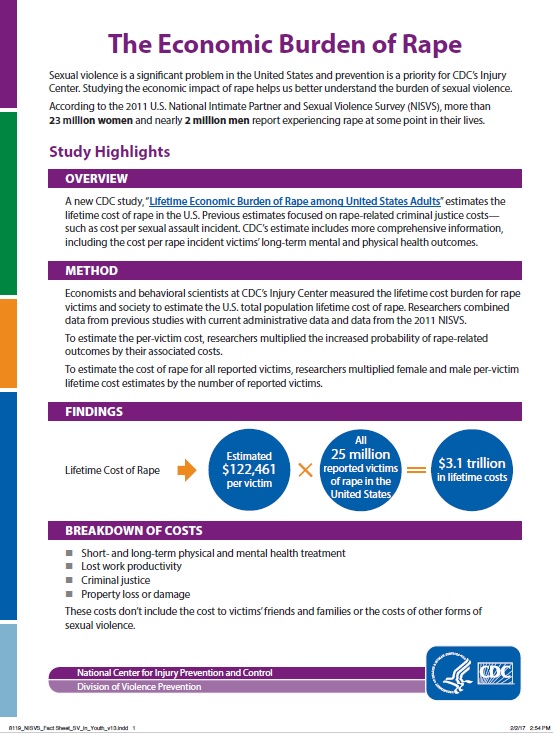Resources Library: Prevention
Start a Search:
STOP SV: A Technical Package to Prevent Sexual Violence

This Centers for Disease Control and Prevention technical package represents a select group of strategies based on the best available evidencde to help communities and states sharpen their focus on prevention activities with the greatest potential to reduce sexual violenced and its consequences. Each strategy includes a rationale, specific approaches, potential outcomes, and evidence.
Summary: Virginia’s Plan for Primary Prevention of Intimate Partner Violence

The Virginia Sexual and Domestic Violence Action Alliance (Action Alliance), with the Centers for Disease Control and Prevention (CDC), entered into a Cooperative Agreement for the purpose of building capacity to prevent IPV in communities throughout the Commonwealth. The Cooperative Agreement, called DELTA (Domestic Violence Prevention Enhancement and Leadership Through Alliances), began in 2003 and continues today.
A major aspect of DELTA has been development of the statewide “Virginia Intimate Partner Violence Prevention Plan,” based on a systematic 10-step planning process called “Getting to Outcomes.” The goal was to create and implement evidence-based strategies that prevent first-time perpetration of intimate partner violence. This document summarizes the 5 goals developed during the planning process.
Published by Virginia Sexual & Domestic Violence Action Alliance. 2009.
4 pages.
Systematic Review of Primary Prevention Strategies for Sexual Violence Perpetration

This systematic review from 2014 had two goals related to looking at primary prevention strategies for sexual violence: 1) to describe and assess the breadth, quality, and evolution of evaluation
research in this area; and 2) to summarize the best available research evidence for sexual violence prevention practitioners by categorizing programs with regard to their evidence of effectiveness on sexual violence behavioral outcomes in a rigorous evaluation.
The study found 3 strategies that had significant effects on sexually violent behavior in a rigorous outcome evaluation: Safe Dates (Foshee et al., 2004); Shifting Boundaries (building-level intervention only, Taylor, Stein, Woods, Mumford, & Forum, 2011); and funding associated with the 1994 U.S. Violence Against Women Act (VAWA; Boba & Lilley, 2009).
The Economic Burden of Rape - a CDC Report
 Sexual violence is a significant problem in the United States and prevention is a priority for CDC’s Injury Center. Studying the economic impact of rape helps us better understand the burden of sexual violence. According to the 2011 U.S. National Intimate Partner and Sexual Violence Survey (NISVS), more than 23 million women and nearly 2 million men report experiencing rape at some point in their lives.
Sexual violence is a significant problem in the United States and prevention is a priority for CDC’s Injury Center. Studying the economic impact of rape helps us better understand the burden of sexual violence. According to the 2011 U.S. National Intimate Partner and Sexual Violence Survey (NISVS), more than 23 million women and nearly 2 million men report experiencing rape at some point in their lives.
A new CDC study, “Lifetime Economic Burden of Rape among United States Adults” estimates the lifetime cost of rape in the U.S. Previous estimates focused on rape-related criminal justice costs—such as cost per sexual assault incident. CDC’s estimate includes more comprehensive information, including the cost per rape incident victims’ long-term mental and physical health outcomes.
Click below to download the report of the study or the summary infographic.
Title IX and Dating Abuse from Break the Cycle
Title IX of the Education Amendments of 1972 (“Title IX”) is a Federal civil rights law prohibiting discrimination on the basis of sex in any federally funded education program or activity. While public focus lately has been placed on better implementing Title IX at colleges and universities, very little has been dedicated to how the law should work in secondary schools. This document addresses the need for efficient Title IX implementation in secondary schools.

